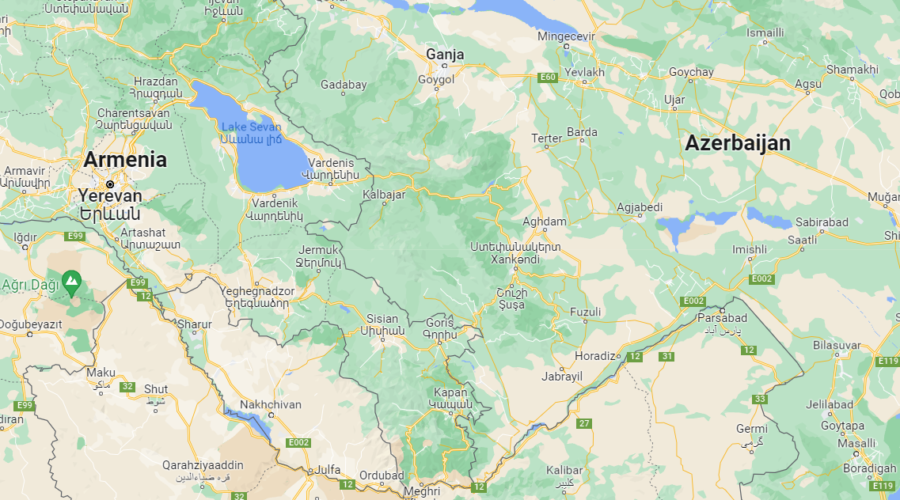The United States seems to be the only major power that can prevent an escalation of the Nagorno-Karabakh conflict. Although the South Caucasus has traditionally been in Russia’s geopolitical orbit, Moscow, bogged down in Ukraine, is unlikely to have capacity to deal with the ongoing crisis in the mountainous region of Azerbaijan that has been under the Armenian control for decades.
#AZE media sources reveal new video footage with local #ARM🇦🇲 armed groups reportedly transferring arms and ammunition in #Karabakh escorted by #RUS 🇷🇺 peace forces. This is the second video footage with allegedly arms transferring in a row. pic.twitter.com/vqXZGPNQT1
— Fuad Shahbazov (@fuadshahbazov) March 11, 2023
On March 11, Azerbaijani Defense Ministry released footage of military vehicles allegedly carrying personnel of Armenian Armed Forces units and “illegal Armenian armed groups accompanied by the Russian peacekeeping contingent” in Nagorno-Karabakh. In other words, Baku accused Yerevan and Moscow of smuggling weapons to the Karabakh Armenians. Although Armenia denied such claims, Azerbaijan’s Defense Ministry said that the country’s military should “take suppressive measures against the possible threats of Armenia, which is trying to create fake tension in the region”. According to Azerbaijani military officials, Baku should “respond adequately if necessary”.
Such rhetoric came a day after Kristina Kvien, the United States Ambassador to Armenia, stressed that the Lachin corridor – the only transportation route connecting Armenia and Nagorno-Karabakh – “should be opened immediately”. Indeed, the Lachin corridor has been blocked since December 12, when Azerbaijani protesters claiming to be environmental activists stopped traffic by setting up tents. Azerbaijan seems to be using the Lachin Corridor blockade as a method of pressure on Armenia, aiming to force Yerevan to fully implement the 2020 ceasefire deal the two countries’ leaders signed in Moscow.
According to the Russian-brokered agreement, all economic and transport links in the region must be unblocked. Azerbaijan, as the clear winner of the 44-day war the two archenemies fought over Nagorno-Karabakh in 2020, insists on a construction of the Nakhchivan Corridor, also known as the Zangezur Corridor – a road and a railway that should connect mainland Azerbaijan with its exclave of Nakhchivan through Armenia’s territory. If built under the Azeri terms, such a transportation network would limit Yerevan’s sovereignty over parts of Armenia’s Syunik province bordering Iran, since Baku is interested in the creation of a land passage without any passport or customs controls.
Besides Armenia, Iran also seems to oppose the construction of the Nakhchivan corridor, quite aware that it would help Azerbaijan to establish a direct link with its ally Turkey. Moreover, the Islamic Republic is worried about the growing military ties between the energy-rich Caucasus nation and Israel. Tehran fears that Baku could allow the Jewish State to use Azerbaijani territory for potential attacks on Iran. Azerbaijan, on the other hand, continues arresting Shia figures, fearing that the Islamic Republic could use them as an instrument to destabilize the Caucasus nation. Both, Azerbaijan and Iran are Shia-majority countries, although besides religion they have very few things in common. Baku and Tehran have different allies, different priorities and different geopolitical goals.
It is, therefore, not surprising that some Azerbaijani media have reportedly accused Iran of blocking Nakhichivan. If true, Armenia could, at least to a certain extent, benefit from such a move. However, given that Baku and Yerevan have recently resumed Western-brokered talks that should lead to a peace agreement between the two nations, it is rather questionable if the Armenian political leadership is interested in additional tensions in the region.
Still, the situation in the South Caucasus remains rather strained. The International Crisis Group warned on January 1 that “the danger is that the talks go nowhere or another flare-up sinks both the Moscow-led and West-backed tracks, and Azerbaijan takes what it can by force.” Although Russia aims to preserve the region in its geopolitical orbit, neither Armenia nor Azerbaijan seem to be satisfied with the role the Kremlin is playing in Nagorno-Karabakh. Baku is waiting for 2025, which is when the Russian peacekeeping troops’ mandate expires, to establish full control over the region. The Karabakh Armenians, for their part, frequently protest against the Russian peacekeepers, accusing them of not being able to ensure security in the region.
Since Yerevan does not have capacity to protect the Armenians in Nagorno-Karabakh, their leaders have started holding direct talks with Azerbaijan, even though Baku’s goal is to reintegrate them into Azerbaijani society, which is something most of them strongly oppose.
“We aren’t going to give Azerbaijan a mandate to commit ethnic cleansing or genocide in Nagorno Karabakh”, said Armenia’s Prime Minister Nikol Pashinyan on March 14.
Although Armenia’s room for political maneuver is rather limited, it is expected to attempt to ensure the Karabakh Armenians’ rights, namely through negotiations with Baku, as well as with other regional and global actors. That is why Yerevan insists on international presence in Nagorno Karabakh, which should continue after the expiration of the Russian peacekeepers’ initial mandate in November 2025. But will Azerbaijan, strongly backed by Tukey and Israel, accept any international troops in the region?
One thing is for sure: under the current circumstances, the United States, rather than Russia, remains the only actor that can preserve the status quo in the South Caucasus. But in the long-term, unless Washington pressures Baku and Yerevan to reach a lasting peace agreement, another round of escalation in the region seems to be inevitable.

